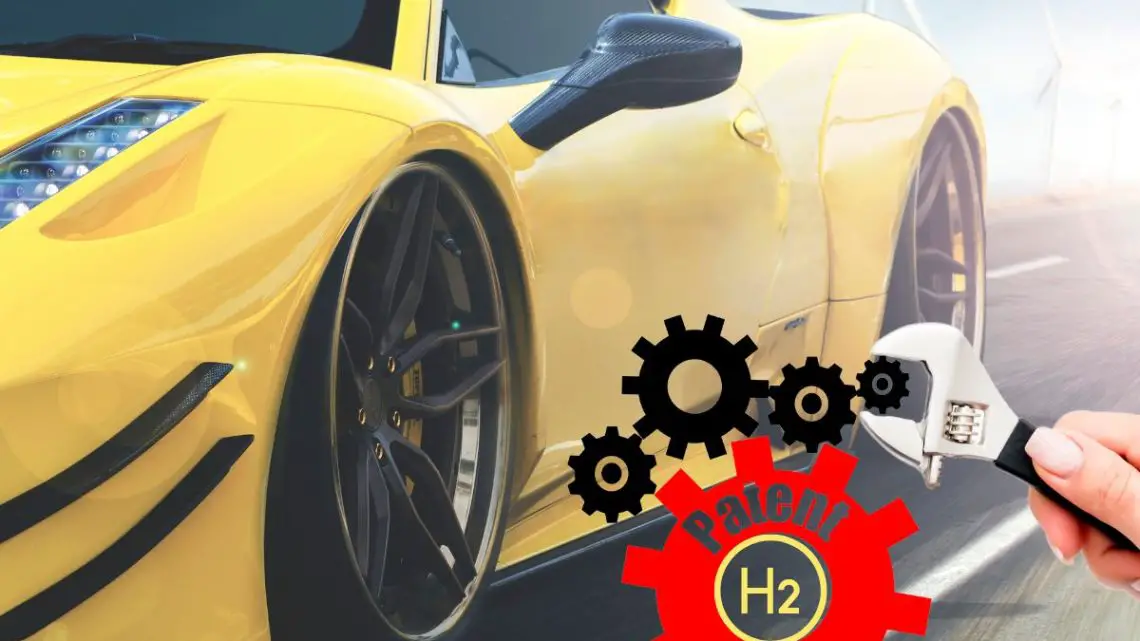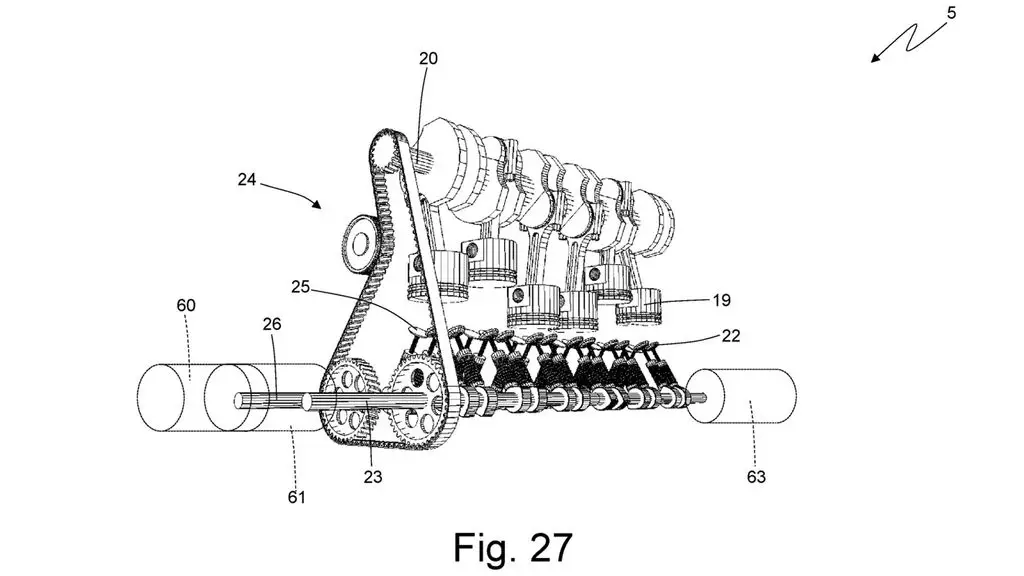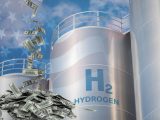
Ferrari’s Upside-Down Hydrogen Engine Could Reshape High-Performance Autos
March 27, 2024In a move that has car enthusiasts and industry experts talking, the iconic Italian sports car manufacturer Ferrari has recently filed a patent for an innovative hydrogen combustion engine that could significantly impact the future of high-performance vehicles.
—
Maranello, Italy – Ferrari, a name synonymous with cutting-edge automotive engineering, has made headlines with its patent for a ground-breaking hydrogen combustion engine. This remarkable design overturns traditional conventions—quite literally—with the engine mounted upside down in the pursuit of enhanced aerodynamics and performance.
Hydrogen combustion engines (HCEs) are at the forefront of an automotive revolution, promising a combination of high efficiency and low emissions. Major players in the industry, such as Toyota with its Corolla Cross H2 Concept, and Cummins with their hydrogen-powered trucks, have already marked their territory in this burgeoning field.

Ferrari Upside Down Engine Design – Image Credit: espacenet.com
Yet, Ferrari’s patent reveals a concept that could potentially leapfrog the efforts of its competitors. The proposed engine boasts an inline-six configuration favored not just for its power delivery but also for facilitating the integration of hydrogen tanks strategically positioned on either side.
The Hydrogen Engine Design and Potential Impact on Performance
This unconventional upside down arrangement allows for a higher placement of the transaxle, paving the way for a more aggressive rear diffuser. All this is achieved without compromising the vehicle’s length, retaining a short wheelbase which Ferrari deems crucial for a true sports car experience.
“In our continuous search for innovative powertrain solutions, we have looked at every element through the lens of performance and sustainability,” explains Fabrizio Favaretto, Vehicle and Powertrain Architectures Innovation Manager at Ferrari. Favaretto, a veteran with over two decades at Ferrari, oversees the development of novel vehicle and powertrain architectures.
Innovations in Forced Induction: Elevating Hydrogen Power
Ferrari’s patent describes various incarnations of forced induction to supplement the hydrogen combustion. One design suggests dual centrifugal compressors driven by an electric motor, powered by regenerative braking. Another features an MGU-H-styled system utilizing an exhaust gas turbine. Interestingly, a third version hints towards a purely mechanical approach, directly channeling power from the dual-clutch transmission to drive superchargers.
Addressing potential maintenance concerns, Ferrari ensures accessibility. With oil and coolant pumps driven from the camshafts at the base of the mounted engine, technicians can easily reach them. Additionally, certain sections of the diffuser double as an engine cover, simplifying access to core components.
A Paradigm Shift in Automotive Engineering: Ferrari’s Vision of Hydrogen-Powered Supercar Dominance
The ripple effects of Ferrari’s audacious design extend beyond performance metrics. It underscores the marque’s unwavering commitment to innovation and its readiness to explore the less trodden path of hydrogen fuel within the sector’s stringent and evolving environmental standards.
The end product as Ferrari envisions it is no less ambitious than a supercharged, hybrid, all-wheel-drive sports car powered by hydrogen combustion—an engineering feat that redefines the boundaries of automotive design.
While hydrogen fuel technology is still in its infancy within the context of commercial transportation, Ferrari’s bold vision presents a thrilling prospect of what the future holds for sports cars. It represents not just a technical triumph but also a daring step towards eco-friendlier options for car enthusiasts who cherish performance without compromising the environment.
Developments like these further affirm the industry’s adaptability and promise a dynamic, multifaceted future for personal transportation. With the likes of Ferrari steering innovation, the road ahead is anything but ordinary.
About Hydrogen Combustion Engines News:
FAQs about Ferrari’s Hydrogen Combustion Engine Patent Application
Q1: What is unique about Ferrari’s recent patent application?
A1: Ferrari’s patent application stands out because it describes a highly unorthodox vehicle system that includes a hydrogen-powered internal combustion engine among several innovative features. This level of detail and innovation in a single application is unusual.
Q2: Who is credited with these innovative patents?
A2: The patents credit a single inventor, Fabrizio Favaretto, who has been with Ferrari for 24 years and currently serves as the Vehicle and Powertrain Architectures Innovation Manager.
Q3: How does Ferrari’s proposed vehicle system compare to others like the Corvette E-Ray?
A3: While Ferrari’s vehicle shares a basic configuration with the Corvette E-Ray, featuring an engine at the back and an electric motor at the front, the similarities end there. Ferrari’s design includes several unique elements such as an upside-down, hydrogen-fueled inline-six engine.
Q4: Why is the engine mounted upside down?
A4: The engine is mounted upside down to allow room for hydrogen tanks on either side of it and to enable a more aggressive diffuser at the back of the car by placing the transaxle higher up. This configuration also contributes to maintaining a short wheelbase.
Q5: What are some of the innovative features of Ferrari’s hybrid sports car?
A5: The car features forced induction through various methods, including electrically driven compressors and an MGU-H type system. It also highlights the potential use of a battery to store energy generated under braking and discusses multiple configurations for supercharging the engine.
Q6: How does Ferrari plan to address potential serviceability issues with the upside-down engine?
A6: The patent addresses serviceability concerns by designing the oil and coolant pumps to be driven from the camshafts, positioning them at the bottom of the engine for easier access by technicians. Additionally, part of the diffuser doubles as an engine cover that can be removed for maintenance.
Q7: What makes Ferrari’s system stand out from conventional vehicle systems?
A7: Ferrari’s system is notable for its combination of a supercharged, hydrogen-combustion, inline-six engine with all-wheel drive in a hybrid sports car configuration. The incorporation of multiple unorthodox features and flexible forced induction methods makes it distinct.
Q8: Is the information about Ferrari’s patent application widely covered?
A8: Yes, the patent has attracted attention from automotive publications such as Autoguide, indicating interest and discussion within the automotive community about Ferrari’s innovative ideas.
Q9: Are these patents already approved in the EU and US?
A9: As of the information provided, the patents are applications in the EU and US, meaning they are still under review and not yet granted.
Q10: Could the design and features described in the patent change in the future?
A10: Yes, the actual implementation of the design and features described in the patent could evolve based on further development, testing, and the insights of Ferrari’s engineering team. The final product may differ from what is currently outlined in the patent applications.



 With over 15 years of reporting hydrogen news, we are your premier source for the latest updates and insights in hydrogen and renewable energy.
With over 15 years of reporting hydrogen news, we are your premier source for the latest updates and insights in hydrogen and renewable energy.